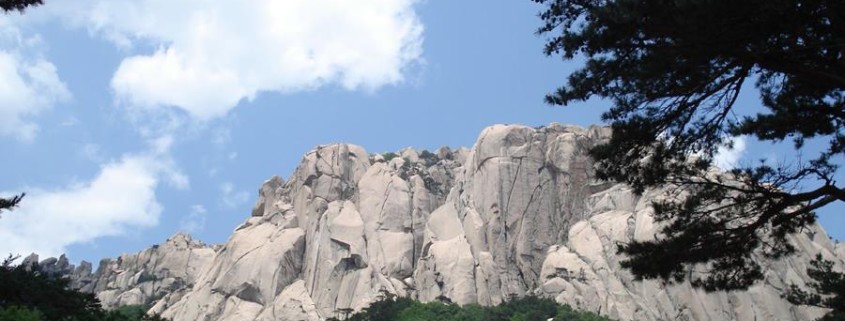Ulsanbawi
Ulsanbawi
The sound of a megaphone pierces the crisp autumn air as masses of people arrive, and stand around the shopkeeper. The man shouts, “Hot kopi! Hot kopi! 2000 won!” in Konglish, because he saw my group of foreign friends approaching. The sound of the megaphone reproduces his voice in a slightly tinny, distorted fashion, and the sound cuts through the peaceful breeze like a dagger. People are crowding around the shop, buying medals to prove their mettle. They are engaging in commerce on the top of a mountain in Gangwon-do. We are on Ulsanbawi Rock. Commerce is inescapable in Korea, even on the peak of one of Seoraksan’s most famous hikes.
We decline the offer of coffee, but the man still wants to help us. “Sajin,” the man says in Korean before quickly correcting himself. “I will take your picture.” At that point, we wonder how much he will charge for this service.
If you are an experienced hiker and you’ve not experienced a Korean hike yet, prepare to have your mind blown. Trails are meticulously kept, hordes of people march the trails like cattle, and there are plenty of stops for pajeon (a type of Korean pancake)and maekgoelli (an unfiltered rice wine), two favorites of Korean hikers. Koreans take to the trail in such volumes that stops as these are not only commercially viable, but a part of the Korean hiking experience. For purists and Western hikers used to open spaces and no people ahead or behind them, watch out for culture shock, or perhaps cultural frustration.
And yet, nowhere in Korea are the native people so friendly. Koreans are at their finest when sporting hiking boots and backpacks. They trade the trademark glum urban scowl and conservative clothing for warm smiles to compliment the cool weather, and colorful hiking apparel. Occasionally they will greet foreigners warmly, in English. Gone are the pointy elbows and “strong-willed” shoulders that can make walking in Seoul so unpleasant.
And no amount of commerce can hide the fact that Seoraksan offers some of the nation’s most beautiful scenery. Visiting the mountain in fall is an extra-special treat. Seoraksan’s diverse variety of trees promises a multicolored journey to the top of the mountain. The fall foliage burns red and orange like aerated cinders, and deciduous trees envelope the sides of the mountains until they give way to evergreens, which paint the canvas an entirely new shade of green. As you trek through the forest, you’ll hear the wind bouncing off the naked rock past the tree line. Up top, the jagged mountainous peaks prod out of the slight haze with vigor and determination, looking majestic.
Although Korea is relentlessly commercial today, the Ulsanbawi trek offers several reminders of the historical role Buddhism has played in the country’s development. No one can miss the gigantic Buddha on the way to the trail, but many will miss the humble temple housed below it. Right by the legendary Heundeulbawi Rock, a teetering rock that cannot be pushed over, is a small hermitage built in 652 by Jajang, a Buddhist monk who used the spot to practice asceticism in Seoraksan’s mountainous splendor.
Flash-forward to now: the shopkeeper is offering to take our picture, and we’re unsure whether he’s planning on charging us. We did turn down the coffee, after all. Nonetheless, Sarah offers her camera to the man and he takes our picture, free of charge. It is true that the scenery of Seoraksan is staggering, breathtakingly beautiful, but with all the hustle and bustle of the trail, it’s hard to call it a contemplative, meditative experience. But thankfully, those who are looking for a quieter, more thoughtful experience are in for a surprise.
The next morning, we woke up to trek the Heulimgol Valley course, a course that has been closed for 20 years due to extreme flooding. Finally open to the public once again, this trail offers the beautiful scenery of Seoraksan Mountains with the quiet, gentle splendor of an uninhabited trail. About 25 people went in our group, and not one of us said a word for the first half hour, instead choosing to take in the scenery completely as we hiked slowly up padded metal stairs.
Upon reaching the top of some peak, we had a full scale view of two valleys. The Heulimgol Valley sat behind us, and on the other side, the Jujeonggul Valley stretched forward, revealing its natural treasures. Both sides were painted with gold, orange, red, and brown leaves. In the distance, barbed, craggy mountains reached in desperation for blue skies. The cold morning wind whipped our sweat-laced backs and necks. There was not one person in front of our group, nor was there one person behind. At that moment, we had escaped from the endless commercialism of Korean culture, and it was just the wilderness and us. Finally, that familiar feeling of union with nature was possible.
Written by: Phillip Ruane, Guri-si, Gyeonggi-Do, Korea
Photography by: Sarah Gray, Guri-si Gyeonggi-Do, Korea
How to get there: I recommend the trip with Adventure Korea as they are affordable and go on both hikes. You can also take the express bus to Osaek Hot Springs. For information on Osaek Hot Springs, click here.
When to go: For beautiful fall foliage, go to Ulsanbawi,Seoraksan as soon as possible.
…brought to you by Adventure Teaching …
- Teaching English in Nowon-gu of Seoul - August 23, 2022
- Teaching English in Cheongju at Chungbuk International Education Center - August 22, 2022
- Teaching English in Gyeongbuk Province English Camps - August 18, 2022




Leave a Reply
Want to join the discussion?Feel free to contribute!